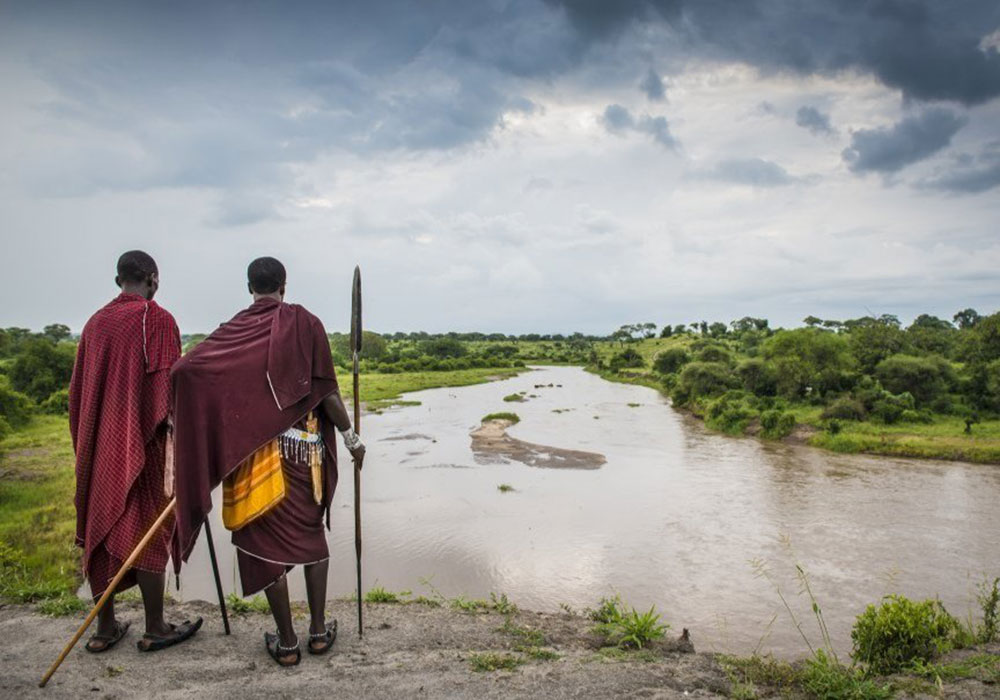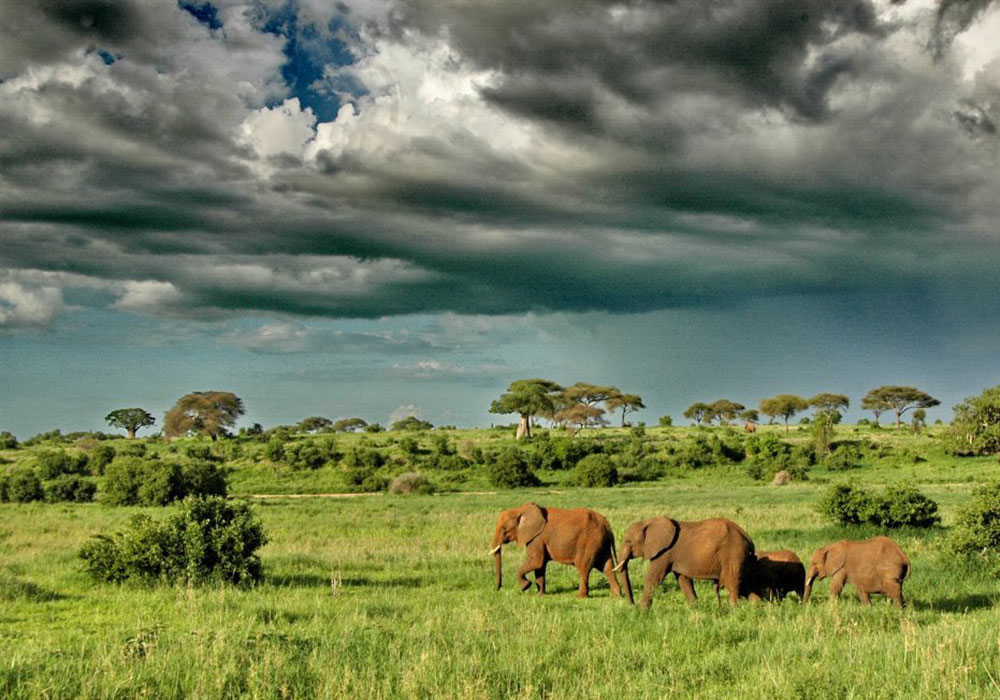Best time to visit Tanzania
A question often asked when planning a safari to Tanzania is: “What is the best time to visit the country?”. We understand that you prefer to travel in the best season: not too hot, not too wet and with excellent wildlife viewing opportunities. So what is the perfect month to visit Tanzania?
Tanzania is a large country with significant differences in landscape and elevation. The seasons can be characterized in two periods: the dry and rainy season. Like everywhere in the world, climate seems to be changing and is becoming less predictable. However, there is still a basic weather pattern to give you a better idea of what to expect in each month of the year.

Match the season to your interest
Unfortunately there is no such thing as the “perfect” season. Tanzania can be well visited all year through. But when and where largely depends on your personal interests. Would you like to witness the famous river crossings of the Wildebeest Migration in the northern part of the Serengeti? Then July up till September give you the best chances. Would you like to stay away from the crowds and benefit from special discounts? Then choose April or May. And climb the Kilimanjaro in September-October or January-February to have the best chances of clear weather.
The parks in the west and south of Tanzania are best to be visited in the dry season (June-October and January-February). Because these areas are less explored than the north, they remain fairly quiet throughout the year.
Month by month travel guide
| Temperature & Rainfall | Wildlife Viewing | Climbing Kilimanjaro | Enjoying the Beach | |
|---|---|---|---|---|
| January | Hot and sunny with little rain. Considered high season and fairly popular for traveling. | The Ndutu plains in the south of Serengeti are teemed with wildlife. Superb bird watching of migratory birds (Nov-March). | Excellent climbing conditions thanks to being dry, warm and clear. | Hot and dry, ideal for sun bathing, snorkeling and diving. |
| February | Also sunny and hot, with limited rainfall. | The best month for witnessing calves being born in Ndutu. Excellent bird watching opportunities. | Warm and dry. Chances of snow on the summit are higher than in the summer season, though the slopes are generally more quiet. | Hot temperatures, perfect beach holiday to escape the cold European winter. Good period for big game fishing. |
| March | High temperatures while humidity builds up. The first rain of the rainy season might appear towards the end of the month. This is also the period that many safari lodges reduce their prices. | Great time for viewing the large herds of wildebeest and zebras, their young ones and many predators in the south of Serengeti. | Still good climbing conditions, especially for the first half of the month. | Warm and fairly sunny, while the beaches are less busy. Great for exploring the mangroves. |
| April | Start of the long rainy season with sometimes heavy rains (mostly at night up till the morning). Lodges will offer great discounts, although a few may close for this month. | Despite of the wet season, game drives continue normally where the tracks are passable. The air has become crisp and clear and there is plenty of water and grass for the animals. | Not the best time for climbing due to the regular rainfall. If you are confined to this period, then consider a route via the northern end which tends to be drier. | Also expect rainfall at the coast and on the islands. A number of lodges close down. |
| May | The rains are getting lighter from the second half of May. Lodges are not busy so often you will receive a special VIP treatment. | The national parks are still relatively little visited, having them almost to yourself. The scenery is green and blooming, and the Ngorongoro Crater floor beautifully covered with flowers. | The rains, especially in the first half, can make the routes slippery and challenging. Therefore May is also not ideal for trekking. | The green scenery makes a gorgeous contrast to the white sandy beaches. While the rains decrease you will still find almost deserted beaches. |
| June | The end of the wet season and start of the 'winter' in Tanzania, though you still might experience a little rain. Especially for the first half of the month you can still benefit from low season rates. | The scenery is beautiful with green vegetation and wild flowers. This however also might make spotting wildlife more difficult due to the long grass. | Climbing season is starting again. As the rain drifts away, it is usually clear of clouds. | The weather is cool, comfortable and sometimes windy. Slowly the beaches are attracting more visitors. |
| July | A popular time for traveling and considered to be peak season. The weather is dry but colder. Pack warm clothing for the chilly evenings and early mornings. | The Wildebeest Migration has arrived in the north where the famous river crossing will take place. In the meantime, the steppes dry up and the vegetation thins out. | Being dry, July is a good month for climbing. It can get very cold though. | The coastline and islands tend to be more crowded. The weather is relatively cool and comfortable, sometimes a bit windy. Average daytime is 26 degrees. |
| August | Still dry and cool. The roads might get dustier, while the savanna plains turn golden in color. There are fewer mosquitoes because of little to no rain. | As bushes dry out and water holes attract more animals, it becomes easier to spot wildlife. Elephants gather in Tarangire NP while the Great Migration remains in northern Tanzania, giving away a spectacular show. | Often cold with a dripping cloud belt hanging over the mountain above the forest and moorland. Chances of clear views are however increasing. | Dry and cool. With August being peak season, make sure to book early as beach resorts get fully booked quickly. |
| September | End of peak season but it can still be quite busy. September marks also the ‘spring’ in Tanzania: temperatures are slowly rising and bushes and trees are blossoming. | Great game viewing with high concentration of wildlife along the rivers. To view the Wildebeest Migration you still have to go to the north of Serengeti. | Cool but clear days with good visibility. September-October are generally one of the best months to plan your climbing expedition. | Blue skies and sunny days while the sea water warms up. |
| October | Warm and generally dry, with occasionally some rain showers. They refresh the air and wash away the dust. | The plains are dry and the grass is short. The herds around the Mara River are slowly preparing their long journey back to the south. | Great climbing conditions with comfortable temperatures. Usually clear mornings and evenings with excellent visibility. | Sunny and warm with little (short) rain. The beaches are now less crowded and so are the (snorkeling) tours. |
| November | November is also part of the wet season, with short rains overnight or late in the afternoon. The days are sunny with still increasing temperatures. Being low season means less crowded parks and lower rates. | Scenery is turning green again although the rains are not likely to affect your game drives. The Migration is moving towards the southern plains in search of fresh grass and water. | Pleasant temperatures but the short rains might affect the climbing route, making it more muddy and slippery. | Generally sunny with some rain showers. A great month to visit Mafia Island to swim with the Whale Sharks. |
| December | Starting to get hot, while some little rainfall still may appear. The first part of the month is still low season. But keep in mind that the second half is very busy over the Christmas period. | The Migration has found its way back south again. Bird watching is at its best, thanks to the migratory birds that have arrived. | Good climbing as rains fade away. And who doesn’t want to have a white Christmas in the snow! | Hot and sunny with rising humidity. Note that many of the beach hotels maintain a minimum stay of 6 nights during the popular festive season. |
Want to know why traveling in the green season is surprisingly beautiful?

Our favorite time to travel
Are you completely flexible in choosing your travel dates? Then we would recommend the months of October, November and March, based on our personal favorite seasons. All three months are generally sunny, warm and dry. There is a lot of activity on the savanna plains, especially in March with the newborn animals. Yet you will avoid the crowds and the parks are more quiet. And with some clever planning, with help from your Tanzania expert, you will still benefit attractive discounts!
